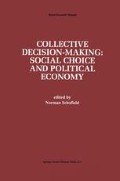Abstract
The purpose of this article is to provide a brief introduction to choice function approaches that examine Arrow’s impossibility result. In Arrow’s original formulation, the problem was to aggregate individual preferences into group preferences, while assuming that both individual and group preferences remained transitive and complete. It has long been recognized, however, that the transitivity of preferences is a strong assumption and in the theory of social choice less demanding properties are argued to be more reasonable.
Access this chapter
Tax calculation will be finalised at checkout
Purchases are for personal use only
Preview
Unable to display preview. Download preview PDF.
References
Aizerman, M. A. 1985. “New Problems in the General Choice Theory: Review of a Research Trend,” Social Choice and Welfare 2: 235–282.
Baigent, N. 1990. “Transitivity and Consistency,” Economic Letters 33: 315–317.
Baigent, N. and Y. Xu. 1991. “Independent Necessary and Sufficient Conditions for Approval Voting,” Mathematical and Social Sciences 21: 21–29.
Baigent, N and Y. Xu. 1992. “Manipulability of Choice Aggregation Procedures and Quota Rules.” Typescript: Tulane University.
Brams, S. J. and P. Fishburn. 1983. Approval Voting. Boston: Birkhauser.
May, K. 0. 1952. “A Set of Independent, Necessary and Sufficient Conditions for Simple Majority Decisions,” Econometrica 20: 680–684.
Moulin, H. 1985. “Choice Functions over a Finite Set: A Summary,” Social Choice and Welfare 2: 147–160.
Plott, C. R. 1973. “Path Independence, Rationality and Social Choice,” Econometrica 41: 1075–1091.
Sen, A. K. 1986. “Social Choice Theory,” in Handbook of Mathematical Economics, Vol. 3, K. Arrow and M. Intriligater, eds. Amsterdam: North Holland.
Suzumura, K. 1983. Rational Choice, Collective Decisions and Social Welfare. Cambridge: Cambridge University Press.
Editor information
Editors and Affiliations
Rights and permissions
Copyright information
© 1996 Springer Science+Business Media New York
About this chapter
Cite this chapter
Xu, Y. (1996). Non Binary Social Choice: A Brief Introduction. In: Schofield, N. (eds) Collective Decision-Making: Social Choice and Political Economy. Recent Economic Thought Series, vol 50. Springer, Dordrecht. https://doi.org/10.1007/978-94-015-8767-9_4
Download citation
DOI: https://doi.org/10.1007/978-94-015-8767-9_4
Publisher Name: Springer, Dordrecht
Print ISBN: 978-90-481-5800-3
Online ISBN: 978-94-015-8767-9
eBook Packages: Springer Book Archive

